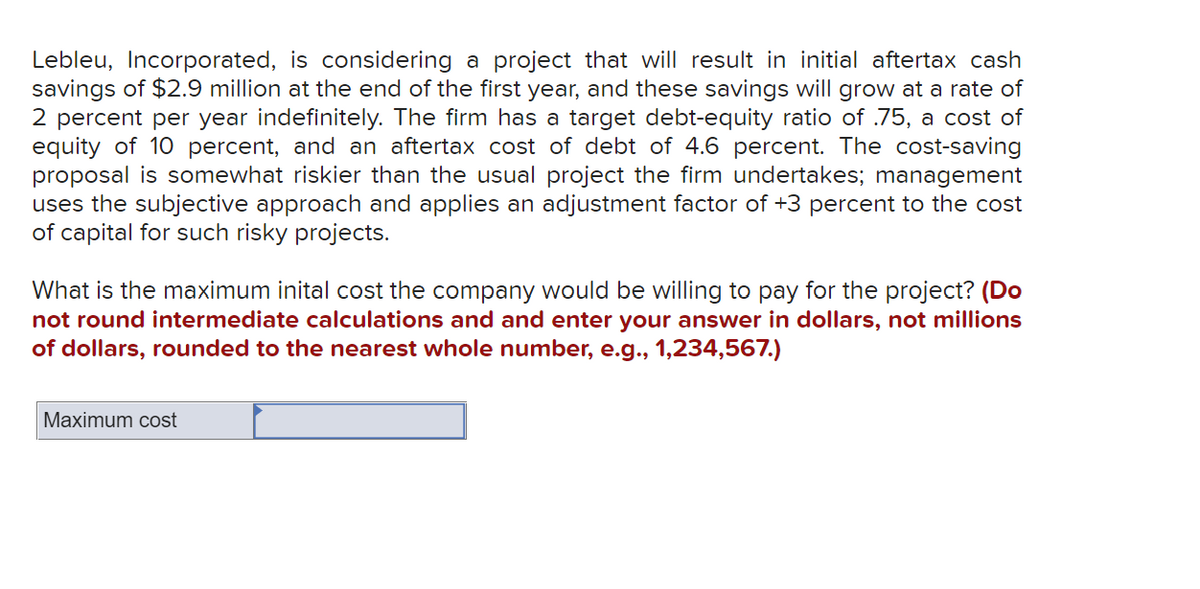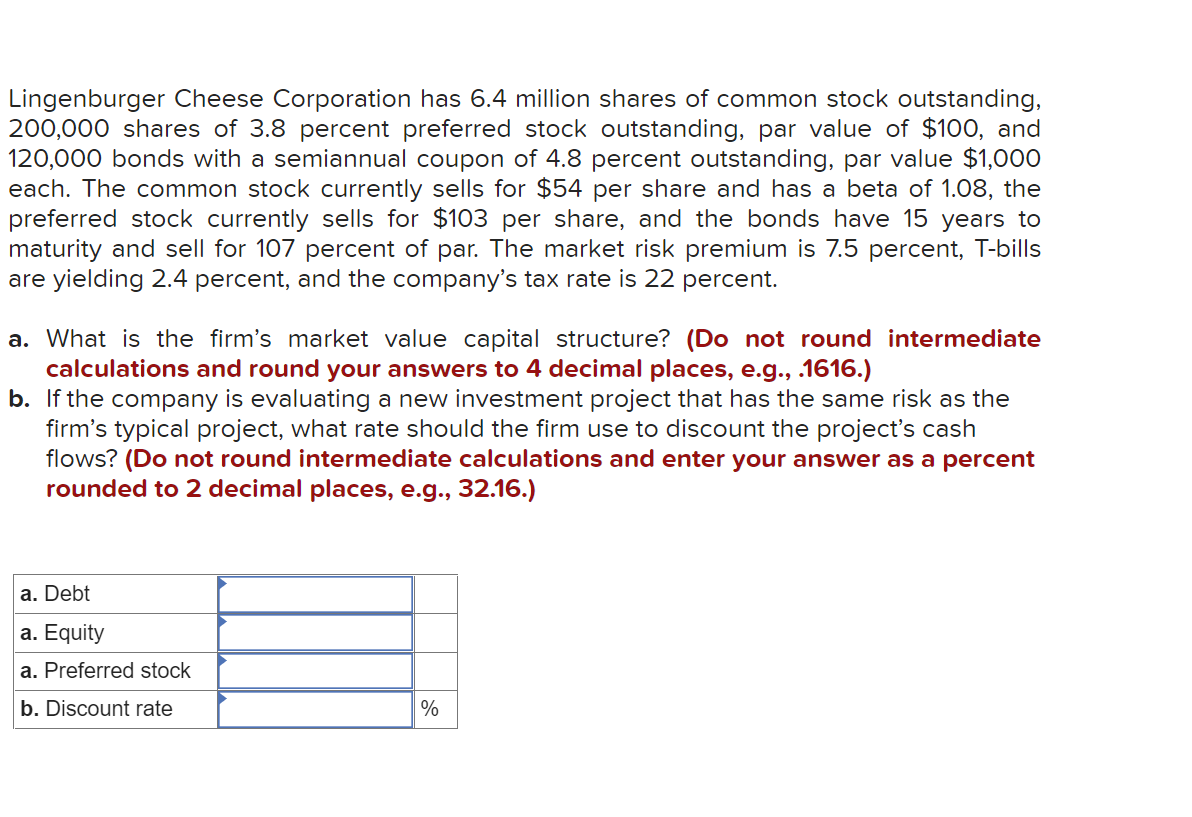Lebleu, Incorporated, is considering a project that will result in initial aftertax cash savings of $2.9 million at the end of the first year, and these savings will grow at a rate of 2 percent per year indefinitely. The firm has a target debt-equity ratio of .75, a cost of equity of 10 percent, and an aftertax cost of debt of 4.6 percent. The cost-saving proposal is somewhat riskier than the usual project the firm undertakes; management uses the subjective approach and applies an adjustment factor of +3 percent to the cost of capital for such risky projects. What is the maximum inital cost the company would be willing to pay for the project? (Do not round intermediate calculations and and enter your answer in dollars, not millions of dollars, rounded to the nearest whole number, e.g., 1,234,567.) Maximum cost
Lebleu, Incorporated, is considering a project that will result in initial aftertax cash savings of $2.9 million at the end of the first year, and these savings will grow at a rate of 2 percent per year indefinitely. The firm has a target debt-equity ratio of .75, a cost of equity of 10 percent, and an aftertax cost of debt of 4.6 percent. The cost-saving proposal is somewhat riskier than the usual project the firm undertakes; management uses the subjective approach and applies an adjustment factor of +3 percent to the cost of capital for such risky projects. What is the maximum inital cost the company would be willing to pay for the project? (Do not round intermediate calculations and and enter your answer in dollars, not millions of dollars, rounded to the nearest whole number, e.g., 1,234,567.) Maximum cost
Chapter20: Financing With Derivatives
Section: Chapter Questions
Problem 15P
Related questions
Question
100%

Transcribed Image Text:Lebleu, Incorporated, is considering a project that will result in initial aftertax cash
savings of $2.9 million at the end of the first year, and these savings will grow at a rate of
2 percent per year indefinitely. The firm has a target debt-equity ratio of .75, a cost of
equity of 10 percent, and an aftertax cost of debt of 4.6 percent. The cost-saving
proposal is somewhat riskier than the usual project the firm undertakes; management
uses the subjective approach and applies an adjustment factor of +3 percent to the cost
of capital for such risky projects.
What is the maximum inital cost the company would be willing to pay for the project? (Do
not round intermediate calculations and and enter your answer in dollars, not millions
of dollars, rounded to the nearest whole number, e.g., 1,234,567.)
Maximum cost

Transcribed Image Text:Lingenburger Cheese Corporation has 6.4 million shares of common stock outstanding,
200,000 shares of 3.8 percent preferred stock outstanding, par value of $100, and
120,000 bonds with a semiannual coupon of 4.8 percent outstanding, par value $1,000
each. The common stock currently sells for $54 per share and has a beta of 1.08, the
preferred stock currently sells for $103 per share, and the bonds have 15 years to
maturity and sell for 107 percent of par. The market risk premium is 7.5 percent, T-bills
are yielding 2.4 percent, and the company's tax rate is 22 percent.
a. What is the firm's market value capital structure? (Do not round intermediate
calculations and round your answers to 4 decimal places, e.g., .1616.)
b. If the company is evaluating a new investment project that has the same risk as the
firm's typical project, what rate should the firm use to discount the project's cash
flows? (Do not round intermediate calculations and enter your answer as a percent
rounded to 2 decimal places, e.g., 32.16.)
a. Debt
a. Equity
a. Preferred stock
b. Discount rate
%
Expert Solution
This question has been solved!
Explore an expertly crafted, step-by-step solution for a thorough understanding of key concepts.
This is a popular solution!
Trending now
This is a popular solution!
Step by step
Solved in 2 steps

Knowledge Booster
Learn more about
Need a deep-dive on the concept behind this application? Look no further. Learn more about this topic, finance and related others by exploring similar questions and additional content below.Recommended textbooks for you

EBK CONTEMPORARY FINANCIAL MANAGEMENT
Finance
ISBN:
9781337514835
Author:
MOYER
Publisher:
CENGAGE LEARNING - CONSIGNMENT


Cornerstones of Financial Accounting
Accounting
ISBN:
9781337690881
Author:
Jay Rich, Jeff Jones
Publisher:
Cengage Learning

EBK CONTEMPORARY FINANCIAL MANAGEMENT
Finance
ISBN:
9781337514835
Author:
MOYER
Publisher:
CENGAGE LEARNING - CONSIGNMENT


Cornerstones of Financial Accounting
Accounting
ISBN:
9781337690881
Author:
Jay Rich, Jeff Jones
Publisher:
Cengage Learning

Intermediate Financial Management (MindTap Course…
Finance
ISBN:
9781337395083
Author:
Eugene F. Brigham, Phillip R. Daves
Publisher:
Cengage Learning